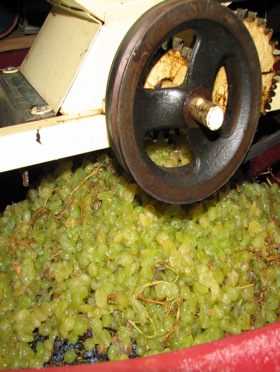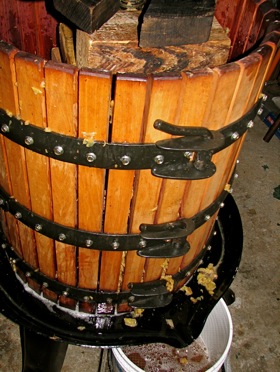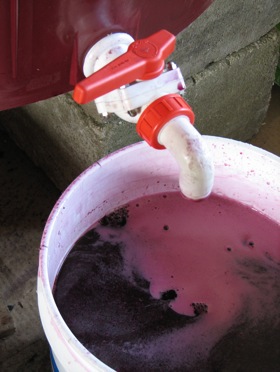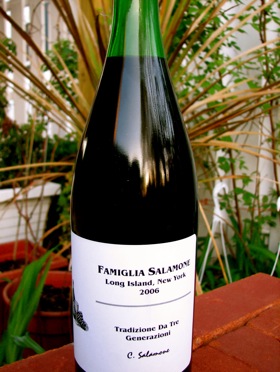The winemaking process is uncomplicated, but it requires several steps and a lot of patience. Together with that, making homemade wine requires a few days of labor and months of fermentation in order for the wine to be ready for consumption. While there are slight variations to the process, this is a time-tested method that was learned through my father. It comes from a long tradition of Italian winemakers from a small mountain town in Italy. That knowledge was later brought to the United States.
Step-by-Step Process: How to Make Homemade Wine
Step One: Gathering the Equipment
Purchasing the right equipment is the first step to making homemade wine. It requires:
An initial fermentation container that is big enough to hold your crushed grapes. It needs to be a high quality plastic container. Modern versions have a drainage nozzle, which makes it easier to transfer the wine juice to the long-term fermentation jugs.
Long-term fermentation containers (carboys or demijohns) that can be glass jugs or oak barrels. The former tends to be more consistent year-to-year. Depending on your batch of wine the sizes can range from 1 to 15 gallons.

 Grape Crusher + Ratchet Basket Grape Press © Gennaro Salamone
Grape Crusher + Ratchet Basket Grape Press © Gennaro Salamone
Plastic tubing that’s at least 6 feet long is required for transferring the juice between containers.
A manual or motorized grape crusher (de-stemmer optional) is needed for squashing the grapes.
A ratchet basket grape press and pressure discs are necessary to squeeze the remaining juice from the grapes in the primary fermentation container.
While some add yeast or tablets, this process doesn’t use additives.
Plastic buckets are required to capture wine from the press and to move the grapes from the initial fermentation container to the press.
A funnel with a strainer is needed to transfer grape juice from the buckets to the demijohns.
Enough cases of grapes to meet your needs are also necessary.
Step Two: Preparing the Equipment
Prepare a large space that will fit your initial fermentation containers, a basket grape press, and the cases of grapes. You will also need an electrical outlet if using a motorized grape crusher. Be sure to wash all of your equipment and to open the cases of grapes and inspect to make sure that the fruit is healthy and ready to be crushed.
Step Three: Crushing the Grapes and Initial Fermentation Container
Place the manual or motorized grape crusher over the initial fermentation container, which is at least a foot off the ground. One person will be ensuring that the machine is in place and another will be responsible for dumping the cases of grapes into the crusher. Fill the container and leave at least a foot of space at the top. The grapes will stay in this container for about a week. Be sure to use a cover. A sheet or similar will do. Be sure to use a closed space.

 Homemade wine © Gennaro Salamone
Homemade wine © Gennaro Salamone
Step Four: Secondary Fermentation and Transfer to the Secondary Containers
Transfer the wine juice to the secondary fermentation container. If you’re using a modern high quality plastic container for the initial fermentation then simply place a bucket under the drainage nozzle. If not, use a plastic tube from the grape-filled container to the buckets. Place the funnel with the strainer into the demijohn and pour the buckets of grape juice into it. Do not fill them up. An airlock will be need for the secondary container for extended fermentation. Start with paper towels for a day or so then use an actual airlock device. The wine juice will remain in these jugs for at least 4-6 months. It’s best to store it in a cool and dark place.
Step Five: Bottling and Drinking
Once the fermentation process has been completed, you are free to bottle the wine. Rack or siphon off the sediments from the wine using a plastic tube while transferring it to the bottles. Cap tightly. At this point, the vinification process has been completed and it’s ready to drink.
___________________________________________________________________________________
 Gennaro Salamone is the founder and editor of Enduring Wanderlust. Feel free to contact him with questions, comments, or inquiries with reference to contributing an article or photograph for publication.
Gennaro Salamone is the founder and editor of Enduring Wanderlust. Feel free to contact him with questions, comments, or inquiries with reference to contributing an article or photograph for publication.
Receive our free content by e-mail directly to your inbox or through an RSS reader.


Tim S
When do I get a bottle of this vino? That looks like a lot of fun. I really love the grape press. It gives off an old-age feeling.
alik
Very prescriptive and colorful 😉
Gennaro
@Tim S – Love grape presses too. We’ll see what we can do about the bottle of vino.
@Alik – Thanks.
Brenda
I love that you and your family have your own brand of wine – how special that the process has been passed on to you from your Italian father!
Anderson
Yeah, I’ll take a jug or two of that. Love the photos and the walk through. Really interesting. Kudos to your pop.
Gennaro
@Brenda – Italy still on the mind?
@Anderson – 5 or 15 gallon jug?
Michael Hodson
I made homemade beer for a few months back when I wasn’t traveling. Was surprisingly good stuff, though I couldn’t figure out how to regulate the alcohol content – so it was deadly 🙂
Peter Brown
Looks like a lot of fun. And work. Though I’m guessing the finally product makes up for any labor put in.
Gennaro
@Michael – Hilarious. Have to watch that alcohol level.
@Peter – It definitely takes work, but if you make enough it can last you for a while.
Ayngelina
I have a lot of respect for people who do this from scratch. I’m a wuss and just head to a wine making shop where I pour a packet into a barrel and show up in 5 weeks to bottle it!
jamie creative cupcakes
I bet this wine tastes amazing. I am thinking about baking some in my cupcakes.
Gennaro
@Ayngelina – Nothing wrong with going with a different method.
@Jamie – That would make some interesting cupcakes. I’d try them.
Erbe
I like the fermentation process when the juice turns into a wine. Thanks for sharing.
Bert
My first try at a cab was a disaster (I think I ended up with some cleaning solution/acid in my batch). Since that first attempt, I have found that it is both a science, and an art! My second batch was good, but not great (still a success if I do say so myself). Cheers…(clink)!